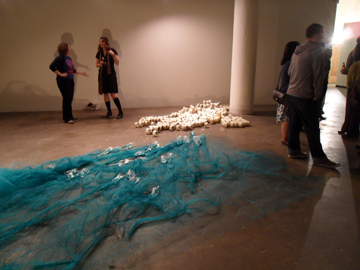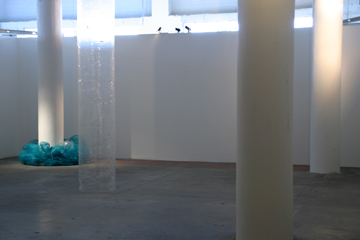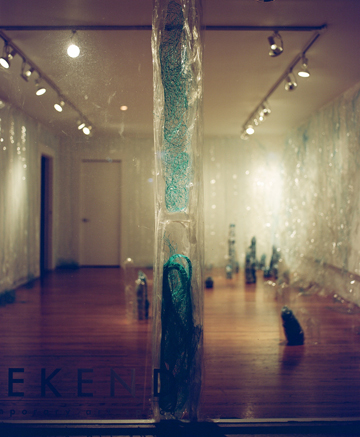
Big Haul: Janne Larsen's installation at Hi-Lite, 2011. Courtesy Carol Cheh.
Editor’s Note: This week, Los Angeles-based writer Carol Cheh fills in for Lily Simonson, who is travelling. Cheh is a writer and curator based in Los Angeles. She is the founder of Another Righteous Transfer!, a blog devoted to documenting LA’s performance art scene, and currently writes for LA Weekly, ArtInfo, and Artillery. Her curatorial projects have included You Don’t Bring Me Flowers: An Evening of Re-Performances (PØST, 2010) and Signals: A Video Showcase (Orange County Museum of Art, 2008).
Earlier this month, I saw Thomas Crow give a keynote address at Pomona College on the occasion of their museum’s exhibition, It Happened at Pomona. Crow tried to make the case that the inventiveness of Los Angeles artists can be partially attributed to the fact that many of them have come at artmaking from other disciplines. He cited James Turrell, who majored in psychology and mathematics at Pomona; Chris Burden, who studied architecture; and an obscure artist named John Ware, who was influenced by Hollywood set design.
Crow’s words struck a chord with me, as I’ve long been intrigued by the collaborative work of Janne Larsen and Sibyl Wickersheimer, two Los Angeles set designers who also make and exhibit art. They are both highly inquisitive people whose mindset is perhaps just a bit different from that of artists who have maintained an exclusive focus on fine art.

Big Haul: Sibyl Wickersheimer's installation at Hi-Lite, 2011. Courtesy Sibyl Wickersheimer.
I first encountered Larsen’s absorbing figurative paintings at a festive art dinner early this year at Hi-Lite project space. A few weeks later in the same space, Larsen and Wickersheimer presented the first iterations of Big Haul, a long-term project in which the two create a series of site-specific installations using a certain set of materials: a few hundred rolls of clear packing tape and over a hundred yards of anti-bird netting.
Like any good work of conceptual art, Big Haul has clear rules: Larsen creates an installation first in the exhibiting space, and Wickersheimer then creates her own installation in response. The materials are always the same, and they may be reused. The pair hope to do a total of eight installations in four different spaces. Influenced by the work they do as set designers, the project is a close examination of the life of materials as well as an exploratory dialogue amongst the two artists, the two materials, and the spaces in which they create their installations.
As we move into the tidal wave that is Pacific Standard Time, which seeks to historicize Los Angeles’ contributions to the art of the 20th century, it is important to make thematic connections where we can with the younger artists who are living and making work in the city right now. I recently sat down with Larsen and Wickersheimer at Weekend Gallery—the site of the third and fourth iterations of Big Haul—to talk about their collaboration, their individual practices, and the unique perspectives they bring to their work.
Carol Cheh: How did the idea for this project come about?
Janne Larsen: As set designers, Sibyl and I both tend to use unusual materials, or we use ordinary materials in an unusual way. In the theatrical world, we usually choose materials based on the emotional landscape of the script that we’re given. So we thought, why don’t we work backwards, and start with two materials, and then build dialogues with those two materials over time—from how those materials relate to each other and how we relate to each other’s installations. What we’d end up with is hopefully a narrative of some sort.
Sibyl Wickersheimer: In our work, we’re always responding to a text, but in this project, we wanted to create our own text using the materials. Not in the sense of a play or storyline, but in the sense of, there’s a story to be told from every material, in fact just its everyday use might be a story. We are hoping that the materials actually get a chance to speak, that we might be able to devise a kind of storyboard of the materials speaking to us, in a way that we wouldn’t see unless we continued the experiment enough to get to that point. We’re hoping to do this a total of eight times, and that might not be enough, or maybe we’ll be so sick of it by then that we won’t want to do it, or maybe we’ll have exhausted the materials because we’ll have cut them down so much by then, I don’t know, but that’s part of the experiment too.

Big Haul: Janne Larsen's installation at Weekend, 2011. Courtesy Kimo Proudfoot.
CC: Can you each tell us about your backgrounds?
JL: I got my undergraduate degree in philosophy, and then I started working in the film industry when I moved to Los Angeles. I really just fell in love with working on a film set, until I realized that I didn’t know shit about it, so I applied to Cal Arts for their set design program, and I got in. Then I got interested in art and installation, and I really was thinking of set design, film work and all that stuff as installation art, just building big worlds.
SW: I went to school for theater and thought I was going to be a director. I never really thought of myself as an artist, but my parents both have architectural backgrounds, and my childhood was filled with going to art museums and plays and concerts. In college, a professor suggested that I take a set design course and literally, the moment I built that first model I was like, this is what I should be doing. Maybe it was my architectural background, being at job sites with my dad from a really young age, but it just made sense. After grad school, I worked as a technical director and assistant technical director for theaters, and I also worked in architecture firms, building a good knowledge base of how to construct things. I made good money doing that, so I was able to rent a studio space, and I started casting stuff and doing various projects. This led me to realize that I have a voice and an aesthetic outside of my work as a theater artist. In the theater world, everything you do is so collaborative—the work that you end up with is never your vision, it’s a collaborative vision, and so it’s nice to be able to do things on your own and also know more about your own reasons for making the aesthetic choices that you do.

Big Haul: Sibyl Wickersheimer's installation at Weekend, 2011. Courtesy Sibyl Wickersheimer.
CC: I’m loving this fluidity between the art and theater worlds, the different concerns and sensibilities, and how you both seem to easily traverse the two. Do you think this is becoming more common, this dissolution of boundaries among disciplines?
JL: I think in the most interesting work, yes. I was just reading this book, Theater in Revolution, which is all about the Russian avant-garde. Picasso had staged this play using Cubist set design and Gertrude Stein said, Picasso paved the way for Cubism to be accepted through the theater. So the precedent has already been set dating back to the early European avant-garde, but on the other hand, the majority of theater you see out there now is mass-appeal musicals, like Cats or Wicked, and they’re not really pushing the boundaries of either theater or art, they’re just emulating past successes. I would hope that dissolving those boundaries would become more and more common, because it would make both art and theater more interesting.
SW: From my point of view, the gaining of skills in your career as an artist is more interesting when you have a wider background. The artwork that I’m always drawn to has amazement in the craft of it—a sense that the artist has learned a craft, added their own ideas to it, then learned yet another craft, and it’s all coming together in this amazing work. I would never want to stop learning about how to construct things; I find so much joy in getting my skills to the next level, that I think that’s what I’ll always be doing. There’s a lot of shows on TV now about instant stardom, so we have this mentality where we expect success without necessarily having any education, craft or experience to have earned it. You don’t see a steady growth, and the artists who have inspired me have that.




Pingback: New Guest Bloggers: #OccupyArt21 | Art21 Blog